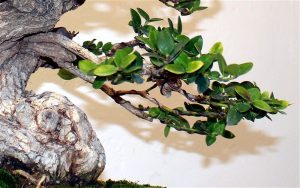The power of the tree as a symbol.
Modern media use many symbolic images to sell computers, cars, and even medicine, despite the fact that analytical specifications would be enough for consumers. Still, other things often need to be expressed as metaphors.
For example, trees have notable roles in the Bible, starting with the Tree of Life and the Tree of the Knowledge of Good and Evil in Genesis and ending in Revelation. In the middle, we see an almond tree in  the story of Zacharias. No doubt these were—and will be—real trees. More symbolic illustrations can be seen in the book of Daniel, the Psalms, or in Jeremiah, not to mention the trees in the parables of Jesus and the teaching of Paul about the olive tree.
the story of Zacharias. No doubt these were—and will be—real trees. More symbolic illustrations can be seen in the book of Daniel, the Psalms, or in Jeremiah, not to mention the trees in the parables of Jesus and the teaching of Paul about the olive tree.
One of the graphic symbols often used by the Caspari Center is a tree. Why? Wouldn’t it be more convincing to just have photos of classrooms, books, or teachers studying in our seminars? Aren’t images of plants and trees already overused?
There are biological facts that can clearly be connected to some challenges we have in the body of Christ today. Nobody expects fruit after the roots of a tree are cut. Without roots, things die. Always. Still, there are believers who think there is no need to know about the original roots of Christianity. Replacement theology neglects the fact that you cannot feed the branches, who are hungry for God, if you are not connected to the roots.
That is why we need illustrations of the roots carrying the branches. And that’s why Caspari Center provides education on the Jewish roots of the Christian faith. We need roots just as trees need them.
Not only are roots a very instructive image; we also have the theme of being grafted, taught by Paul in Romans 11. But how many pastors know that the Gentiles are not grafted in only for themselves, but to bless the original tree? That is another often-forgotten biological fact.
Sandra Teplinsky writes in her book Why Still Care about Israel?:
A horticultural practice in the ancient Middle East was to reinvigorate a cultivated olive tree that had stopped bearing fruit by grafting a wild olive branch into it. The fresh sap, or lifeblood, of the wild olive branches could then begin to bear fruit again.
Everybody benefits in the plan of God. Still, we have believers who think Gentiles should just give financial support to the Messianic movement—not their real, genuine presence. The tree gives us another message. Both parts need new unity in Christ.
think Gentiles should just give financial support to the Messianic movement—not their real, genuine presence. The tree gives us another message. Both parts need new unity in Christ.
More than 10 years ago, I was a brand new graphic designer at the Caspari Center. I was supposed to make a series of posters about our ministry. Other great and important ministries were present as well. They were feeding the poor, building wells, and providing medical care in the third world. I was challenged to convince people that a spiritual need is also a need. I asked my co-worker what I should do graphically. He suggested the idea of planting something that we might see come to fruition only after 10–20 years. When we bless the generations to come, we cannot see encouraging results immediately. It is like a tree; you have to wait. That was the moment I “fell in love” with trees.
So I made an olive tree series with the whole tree, from the roots to the fruits we don’t yet see. The Caspari Center planted the first seeds more than 30 years ago. Some of the fruits are visible today.
For example, the feedback we get from participants in our programs is like leaves. Here are some encouraging quotes from them:
—Thank you for a wonderfully planned and executed program with lots of variety and highly skilled teachers who knew how to communicate the historical background of the biblical texts and relate them to our own lives and context.
—The main workshop was very eye-opening. The subject is very difficult, but important for congregations!
—Thank you for encouraging and strengthening us!
We have to stay rooted, grafted together, and bear fruit, as we are being cultivated by the Great Gardener himself.
What a strong symbol a tree is!
Heidi Tohmola